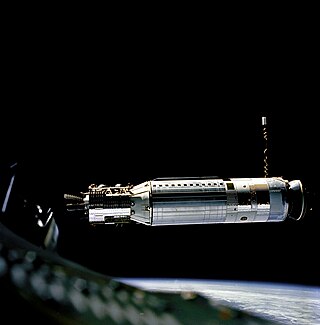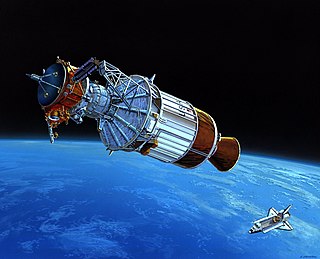Related Research Articles
A monopropellant rocket is a rocket that uses a single chemical as its propellant. Monopropellant rockets are commonly used as small attitude and trajectory control rockets in satellites, rocket upper stages, manned spacecraft, and spaceplanes.

An expendable launch system is a launch vehicle that can be launched only once, after which its components are either destroyed during reentry or discarded in space. ELVs typically consist of several rocket stages that are discarded sequentially as their fuel is exhausted and the vehicle gains altitude and speed. As of 2024, less and less satellites and human spacecraft are launched on ELVs in favor of reusable launch vehicles. However, there are many instances where a ELV may still have a compelling use case over a reusable vehicle. ELVs are simpler in design than reusable launch systems and therefore may have a lower production cost. Furthermore, an ELV can use its entire fuel supply to accelerate its payload, offering greater payloads. ELVs are proven technology in widespread use for many decades.

The RM-81 Agena was an American rocket upper stage and satellite bus which was developed by Lockheed Corporation initially for the canceled WS-117L reconnaissance satellite program. Following the division of WS-117L into SAMOS and Corona for image intelligence, and MIDAS for early warning, the Agena was later used as an upper stage, and an integrated component, for several programs, including Corona reconnaissance satellites and the Agena Target Vehicle used to demonstrate rendezvous and docking during Project Gemini. It was used as an upper stage on the Atlas, Thor, Thorad and Titan IIIB rockets, and considered for others including the Space Shuttle and Atlas V. A total of 365 Agena rockets were launched between February 28, 1959 and February 1987. Only 33 Agenas carried NASA payloads and the vast majority were for DoD programs.

Delta II was an expendable launch system, originally designed and built by McDonnell Douglas, and sometimes known as the Thorad Delta 1. Delta II was part of the Delta rocket family, derived directly from the Delta 3000, and entered service in 1989. There were two main variants, the Delta 6000 and Delta 7000, with the latter also having "Light" and "Heavy" subvariants. During its career, Delta II flew several notable payloads, including 24 Global Positioning System (GPS) Block II satellites, several dozen NASA payloads, and 60 Iridium communication satellites. The rocket flew its final mission, ICESat-2, on 15 September 2018, earning the launch vehicle a streak of 100 successful missions in a row, with the last failure being GPS IIR-1 in 1997. In the late 1990s, Delta II was developed further into the unsuccessful Delta III, which was in turn developed into the more capable and successful Delta IV, though the latter shares little heritage with the original Thor and Delta rockets.

The Delta rocket family was a versatile range of American rocket-powered expendable launch systems that provided space launch capability in the United States from 1960 to 2024. Japan also launched license-built derivatives from 1975 to 1992. More than 300 Delta rockets were launched with a 95% success rate. The series was phased out in favor of the Vulcan Centaur, with the Delta IV Heavy rocket's last launch occurring on April 9, 2024.

Black Arrow, officially capitalised BLACK ARROW, was a British satellite expendable launch system.

Pegasus is an air-launched multistage rocket developed by Orbital Sciences Corporation (OSC) and later built and launched by Northrop Grumman. Pegasus is the world's first privately developed orbital launch vehicle. Capable of carrying small payloads of up to 443 kg (977 lb) into low Earth orbit, Pegasus first flew in 1990 and remained active as of 2021. The vehicle consists of three solid propellant stages and an optional monopropellant fourth stage. Pegasus is released from its carrier aircraft at approximately 12,000 m (39,000 ft) using a first stage wing and a tail to provide lift and altitude control while in the atmosphere. The first stage does not have a thrust vector control (TVC) system.

Little Joe II was an American rocket used from 1963 to 1966 for five uncrewed tests of the Apollo spacecraft launch escape system (LES), and to verify the performance of the command module parachute recovery system in abort mode. It was named after a similar rocket designed for the same function in Project Mercury. Launched from White Sands Missile Range in New Mexico, it was the smallest of four launch rockets used in the Apollo program.

The Scout family of rockets were American launch vehicles designed to place small satellites into orbit around the Earth. The Scout multistage rocket was the first orbital launch vehicle to be entirely composed of solid fuel stages. It was also the only vehicle of that type until the successful launch of the Japanese Lambda 4S in 1970.
A momentum exchange tether is a kind of space tether that could theoretically be used as a launch system, or to change spacecraft orbits. Momentum exchange tethers create a controlled force on the end-masses of the system due to the pseudo-force known as centrifugal force. While the tether system rotates, the objects on either end of the tether will experience continuous acceleration; the magnitude of the acceleration depends on the length of the tether and the rotation rate. Momentum exchange occurs when an end body is released during the rotation. The transfer of momentum to the released object will cause the rotating tether to lose energy, and thus lose velocity and altitude. However, using electrodynamic tether thrusting, or ion propulsion the system can then re-boost itself with little or no expenditure of consumable reaction mass.
Spacecraft design is a process where systems engineering principles are systemically applied in order to construct complex vehicles for missions involving travel, operation or exploration in outer space. This design process produces the detailed design specifications, schematics, and plans for the spacecraft system, including comprehensive documentation outlining the spacecraft's architecture, subsystems, components, interfaces, and operational requirements, and potentially some prototype models or simulations, all of which taken together serve as the blueprint for manufacturing, assembly, integration, and testing of the spacecraft to ensure that it meets mission objectives and performance criteria.
In aerospace engineering, spin stabilization is a method of stabilizing a satellite or launch vehicle by means of spin, i.e. rotation along the longitudinal axis. The concept originates from conservation of angular momentum as applied to ballistics, where the spin is commonly obtained by means of rifling. For most satellite applications this approach has been superseded by three-axis stabilization.

Athena was a 1990s Lockheed Martin expendable launch system which underwent several name changes in its lifetime.

The Inertial Upper Stage (IUS), originally designated the Interim Upper Stage, was a two-stage, solid-fueled space launch system developed by Boeing for the United States Air Force beginning in 1976 for raising payloads from low Earth orbit to higher orbits or interplanetary trajectories following launch aboard a Titan 34D or Titan IV rocket as its upper stage, or from the payload bay of the Space Shuttle as a space tug.

The Star 48 is the largest of a family of solid rocket motors used by many space propulsion and launch vehicle stages, almost exclusively as an upper stage. It was developed primarily by Thiokol Propulsion and after several mergers, is manufactured by Northrop Grumman’s Space Systems division. A Star 48B stage is also one of the few man-made items sent on escape trajectories out of the Solar System, although it is derelict since its use. The Star 48B variant was the PAM-D upper stage used on the retired Delta II rocket.
The Intelsat VI series of satellites were the 8th generation of geostationary communications satellites for the Intelsat Corporation. Designed and built by Hughes Aircraft Company (HAC) in 1983-1991, there were five VI-series satellites built: 601, 602, 603, 604, and 605.

Orbiting Vehicle or OV, originally designated SATAR, comprised five disparate series of standardized American satellites operated by the US Air Force, launched between 1965 and 1971. Forty seven satellites were built, of which forty three were launched and thirty seven reached orbit. With the exception of the OV3 series and OV4-3, they were launched as secondary payloads, using excess space on other missions. This resulted in extremely low launch costs and short proposal-to-orbit times. Typically, OV satellites carried scientific and/or technological experiments, 184 being successfully orbited through the lifespan of the program.

A number of space tethers have been deployed in space missions. Tether satellites can be used for various purposes including research into tether propulsion, tidal stabilisation and orbital plasma dynamics.

Space tethers are long cables which can be used for propulsion, momentum exchange, stabilization and attitude control, or maintaining the relative positions of the components of a large dispersed satellite/spacecraft sensor system. Depending on the mission objectives and altitude, spaceflight using this form of spacecraft propulsion is theorized to be significantly less expensive than spaceflight using rocket engines.
The Star is a family of US solid-propellant rocket motors originally developed by Thiokol and used by many space propulsion and launch vehicle stages. They are used almost exclusively as an upper stage, often as an apogee kick motor.
References
- ↑ "Space debris mitigation: the case for a code of conduct". ESA. European Space Agency. 15 April 2005. Retrieved 14 November 2014.
- ↑ Juno II Summary Project Report, Volume II (PDF) (Technical report). NASA. 1962. D-608.
- ↑ Scott R. Starin and John Eterno (January 2011). "Attitude Determination and Control Systems" (PDF). NASA.
- ↑ "General Description of Sounding Rockets". Johns Hopkins.
- ↑ Dawn Journal, 12 September 2007
- ↑ US 3030049,Pilkington Jr., William C.; McDonald, William S.& Wells, Willard H.,"Satellite spin control",published 1962-04-17, assigned to Secretary of the United States Army
- ↑ Ishii, Nobuaki (March 2005). "Separation motion analysis of sounding rockets using unbalanced YoYo mechanism". ISAS proceedings of 14th Workshop on Astrodynamics and Flight Mechanics 2004: A Collection of Technical Papers: 105–109. ISSN 0918-8053. S2CID 125586338.
In sounding rocket experiments and a final stage of satellite insertion, when the payload section or the satellite is separated from the lower motor, collision of the motor due to the residual thrust should be avoided. Conventionally, a tumble motor (small solid rocket propellant) or Yo tumbler is utilized for the collision avoidance.
- ↑ Krebs, Gunter Dirk. "Ohsumi". Gunter's Space Page. Retrieved 2024-06-28.
- ↑ "Space station crew has close call with space junk". USA Today. March 12, 2009. Archived from the original on March 25, 2009.